Mary Peltola is going to the US House. The former state House member will become the first Alaska Native to serve in Congress after winning the state’s first ranked choice election on Wednesday. Peltola will serve out the remainder of the term of former Representative Don Young, who passed away in March.
Peltola maintained her lead in Round 1 to beat out Republicans Sarah Palin and Nick Begich with a final total of 91,206 votes, or a little over 51 percent. After Begich was eliminated in the first round of ranked-choice tabulations, the second-place votes on his voters’ ballots were redistributed. But they weren’t enough to grant victory to Palin, a former Alaska governor, vice presidential nominee, and far-right political celebrity. She captured 49 percent of the final vote. Alaska Division of Elections director Gail Fenumiai announced the results on a Facebook livestream.
Did Alaska’s new election system work as predicted?
Before the election reforms passed in November 2020, I wrote, “No voting system is absolutely perfect, but … ranked choice voting is better than the more prevalent winner-takes-all system at strengthening democracy.” After they passed, I called it a “cure for US elections.”
In ranked choice voting, voters rank candidates from most- to least-favorite. In Round 1, any candidate who wins a majority of first-place votes wins. If no one secures a majority, the last-place candidate leaves the race and a new round begins. In Round 2, the second-place votes from the ballots of the candidate defeated in Round 1 get redistributed among the remaining candidates. The process continues until a candidate secures a majority of the voted ballots.
I wrote that Alaska’s new system would likely have the following benefits: making campaigns less polarized and, possibly, more civil than the status quo; being easy for voters to understand; checking the power of political parties and hyperpartisan primary voters; leveling the playing field for candidates from underrepresented groups; improving voter turnout; and ensuring no candidate can win without a majority in the final round.
Alaskan voters adopted ranked choice general elections, along with open primary elections, in November 2020. Many supported the reforms based on these anticipated benefits. And while the US House special election only gives us a single Alaska data point when it comes to ranked choice voting, it’s worth examining whether the new system delivered.
Campaigns may become more civil and less polarized
The apocalyptic tropes of left vs. right that so often characterize US elections didn’t dominate this one. Peltola radiated warmth throughout the campaign. She snapped selfies with her Republican opponents, spoke of her support for drilling in the Arctic National Wildlife Refuge, and shared laughs with Palin over their time as pregnant politico moms working in Juneau. (Peltola served in the state House while Palin was governor.) Palin even called her a “sweetheart.”
But civility did not exactly rule the day. With only one Republican expected to survive Round 1, the two conservatives turned on each other. Begich ran ads calling out Palin for leaving the governorship before her term ended to chase fame and fortune outside Alaska. Palin questioned Begich’s credentials as an Alaskan, threw shade on his relative lack of political experience, and cast doubt on his fealty to the Republican cause. (Begich did say he’d rank Palin second, but the ads spoke for themselves.) It didn’t have to go that way. A different set of Republican candidates may well have worked together to drum up votes for each other.
Peltola’s victory meant the least polarizing candidate actually won.

Peltola’s victory meant the least polarizing candidate actually won. Peltola is a moderate Democrat. Like Sen. Lisa Murkowski, she supports abortion rights and cares deeply about the welfare of indigenous people and the health of the salmon runs across the state. She will also defend the oil and gas drilling that is important to the state’s economy, saying she supports drilling in the Arctic National Wildlife Refuge. But Peltola’s stance on resource extraction is nuanced. She once worked for the Donlin gold mine but has said she no longer supports the project and also opposes the Pebble Mine.
Peltola isn’t the first Democrat to win in Alaska in recent memory. Former Sen. Mark Begich, a Democrat (and Nick Begich’s uncle), beat former Sen. Ted Stevens in 2008. Democrats can win in this predominantly Republican state in cases when candidates on the right are particularly vulnerable. In Begich’s case, Stevens was under investigation for felony corruption.
Peltola, meanwhile, benefited from Palin’s polarizing reputation. A significant majority of Alaskans just don’t like Palin, and the new system was able to reflect that fact. Of the 53,756 voters who ranked Begich first, about 28 percent ranked Peltola second and another 21 percent didn’t give Palin their second-place votes. Despite the Republican Party’s admonition to its voters to “Rank the Red,” only 50 percent of Begich voters actually did. Had Begich, a more conventional Republican and party-approved to boot, made it through Round 1, Peltola may well have lost.
Despite the Republican Party’s admonition to its voters to “Rank the Red,” only 50 percent of Begich voters actually did.

Voters will find ranked choice voting easy
Detractors of ranked choice voting often argue that the system is too confusing for voters to understand. But a large majority of Alaskans found the act of ranking easy. An exit poll by Patinkin Research Strategies released on Aug. 30, found that 85 percent of respondents said ranked choice voting was “simple”: about 57 percent said it was “very simple” and 28 percent said it was “somewhat simple.” Just 6 percent said it was “very difficult.”
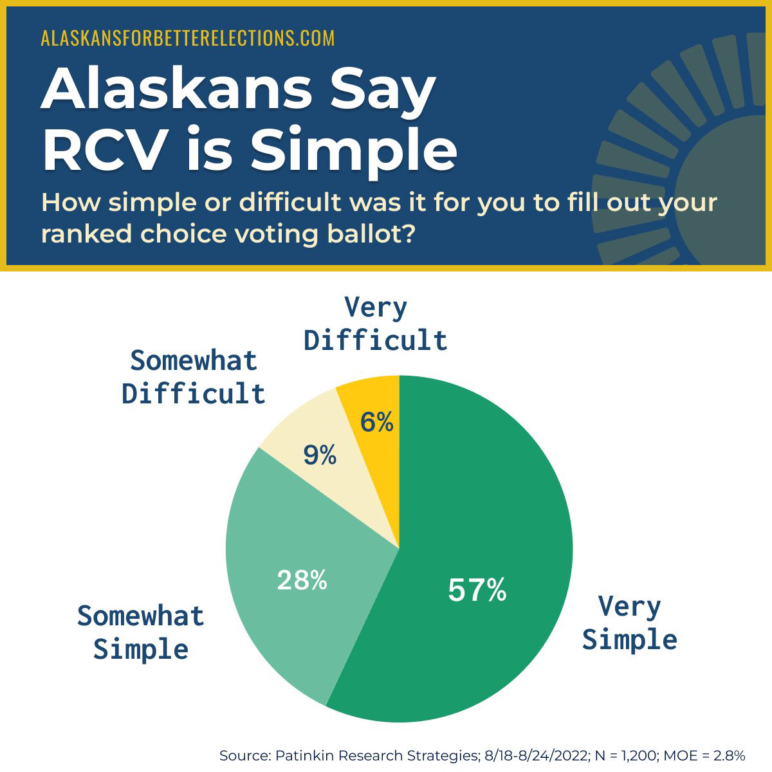
Graphic courtesy of Alaskans for Better Elections
In the weeks leading up to the election, many voters were focused on the question of whether they needed to rank all the candidates. (Answer: No, but there was little reason for voters to choose just one.) Ultimately about a third of voters surveyed ranked just one candidate. Another 38 percent ranked two candidates and 28 percent ranked all three. Overall, though, fully 95 percent of Alaskans reported receiving information about ranked choice voting in advance of the election, and nearly two-thirds said they liked the new open primaries system as well.
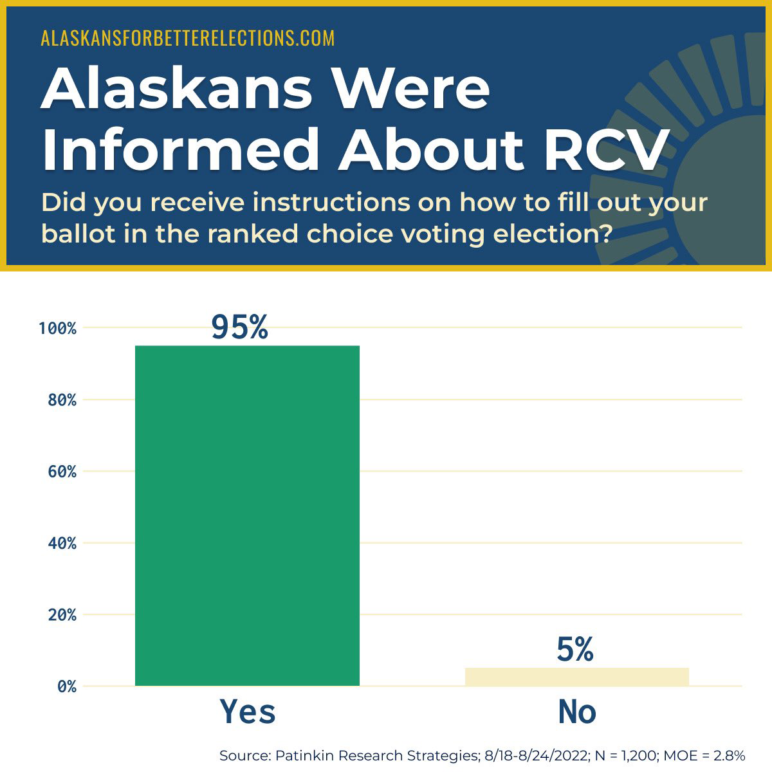
Graphic courtesy of Alaskans for Better Elections
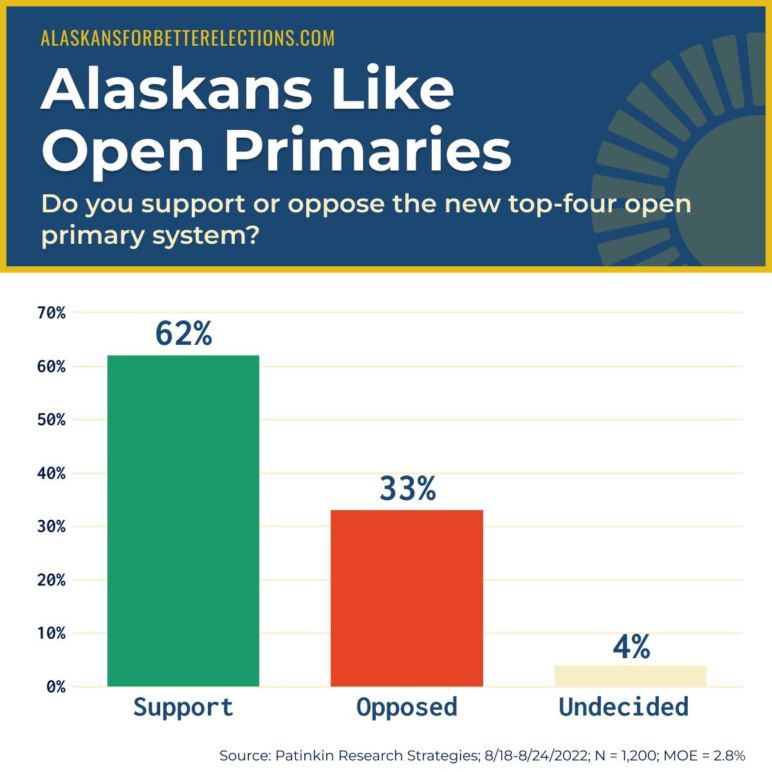
Graphic courtesy of Alaskans for Better Elections
The gatekeeping power of political parties will likely wane
Open primaries and ranked choice elections did indeed weaken the power of Alaska’s political parties and hyperpartisan voters to set the menu for the general election. The state moved to a pick-one open primary, where all candidates appeared on a single ballot available to all registered voters. The top four vote-getters then advanced to the general election.
Open primaries benefited Palin, Murkowski, and Peltola, none of whom were the top choices of their parties, but whom the general pool of voters supported. It also allowed many more candidates than usual to throw their hats in the ring, giving voters more choice than they had under the old closed system.
Begich’s endorsements from Alaska’s Republican establishment weren’t enough to propel him out of the first round, revealing the disconnect between the party and its voters. Under the old system, Begich would have easily advanced to the general election and likely won. But voters, knowingly or not, took the opportunities presented by the open primary and ranked choice voting to go their own way. Palin benefited, at least briefly, by securing the most votes in the open primary and outlasting Begich in the ranked choice general.
Begich’s endorsements from Alaska’s Republican establishment weren’t enough to propel him out of the first round, revealing the disconnect between the party and its voters.

Peltola wouldn’t have been in the race either. The candidate most likely to have been the Democratic nominee under the old system was Anchorage Assembly member Chris Constant. As Midnight Sun political blogger Matt Buxton put it, the new system created a
“free-for-all on the Democratic side of the ticket with many, many candidates old, new, known and unknown all vying for a limited amount of air. … It was former state legislator Mary Peltola who emerged and who the party ultimately rallied around. That’s a big deal for a party that’s been going through an identity crisis over much of the last decade.”
Murkowski, meanwhile, running as the incumbent for US Senate, likely would have been “primaried” by a right-wing candidate, as she was in 2010. But she managed to win 45 percent of the vote under the new open primary system. Her main rival, Kelly Tshibaka, received the Alaska Republican Party’s endorsement but only 39 percent of the primary election vote.
Open primaries also affected Legislative races. With only one contested race, involving five candidates, all but one candidate breezed through the primary and onto the general election ballot. Former state Senate president Cathy Giessel, for example, who lost her primary race in 2020, finished first in 2022 and appears primed to retake her seat from a more populist Republican, Roger Holland.
The open primary also acted as a poll, allowing some candidates to drop out before expending time, energy, and political capital on a losing campaign. Tara Sweeney, a former US House candidate, is the most prominent example. Several legislative candidates also announced they do not intend to run in November.
The playing field may become more level for candidates from underrepresented groups
We’ll be exploring Alaska’s candidate demographics further in an upcoming article. But as mentioned above, the old system likely would not have given Alaskans two women, including one who is both white and Alaska Native, the opportunity to compete in the general election for US House.
Voter turnout may improve
At about 32 percent, Alaska’s primary voter turnout is the highest it’s been in the three election cycles since the state began automatically registering voters through the Permanent Fund Dividend application process. In 2018, the primary election turnout was 20 percent. In 2020, primary turnout was 23 percent.
Of course, it’s difficult at this stage to draw a causal link between election system changes and voter turnout since other factors are at play. The high-profile special general election to replace Representative Don Young, who served in the US House for nearly 50 years, no doubt played a role as well.
The 15-day delay in results reporting allowed for overseas ballots, many from members of the military, and in-state ballots from mostly rural areas with spotty mail service to arrive.

In another upside for voters, late ballots were far more consequential in the ranked choice election than they have been in typical winner-take-all elections. The special general election for US House happened on August 16, the same day as the regular primary election, but results didn’t come out until August 31. The 15-day delay in results reporting allowed for overseas ballots, many from members of the military, and in-state ballots from mostly rural areas with spotty mail service to arrive. The grace period is standard practice for Alaska, but under the old system these ballots didn’t matter as much for the final results.
No candidate can win with less than half the vote
That’s what happened. Peltola secured 51 percent of the votes in the final round to win.
What’s Next?
Palin, Begich, and Peltola will run again for the regular US House term in November, so we’ll see whether voters and candidates adjust their strategies or not. It’s highly possible we’ll see a different result. We’ll also see how the US Senate and governor’s races shake out using the ranked choice system.

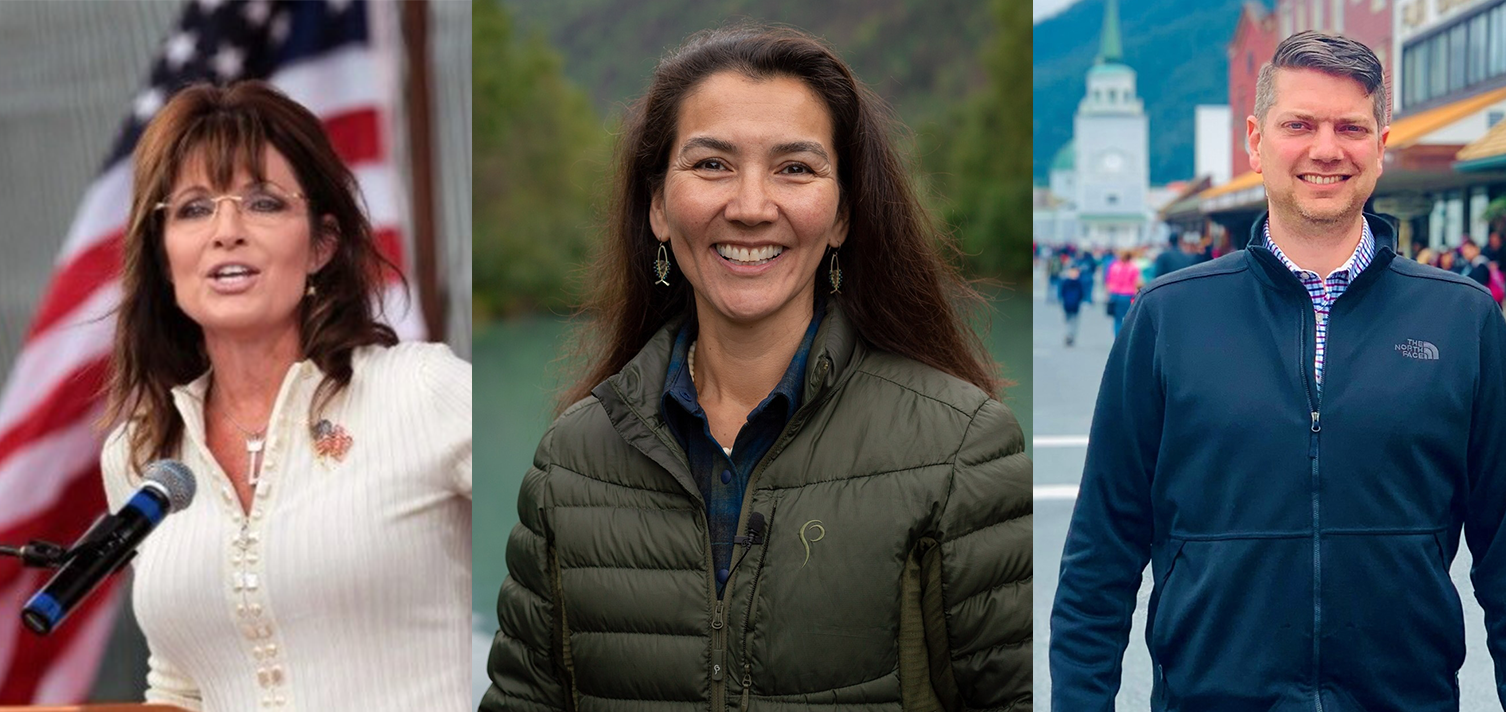
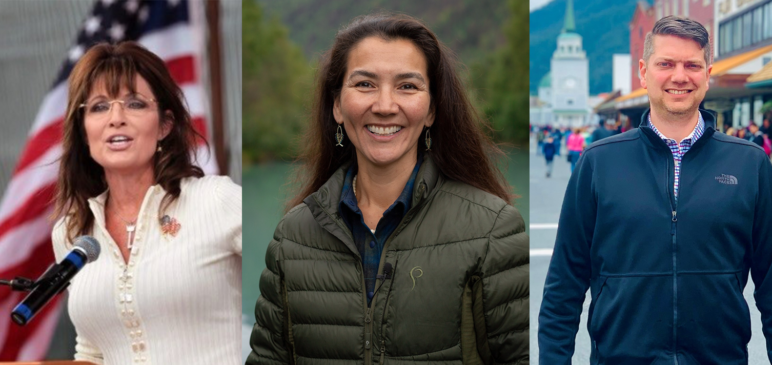









Ted Larkin
What an outstanding article! Among other reasons, I now have a clear understanding and appreciation of ranked choice elections policy. Thank you.
John Whitmer
This is an excellent review of the recent Special Congressional election. And it’s a fine description of RCV and the advantages proponents claim. Whether or not the advantages in any one election play out to the extent proponents expected is perhaps debatable. But several points are undeniable:
1. RCV is not confusing. The vast majority of voters do not find it difficult.
2. RCV, as well as open primaries, lessen the influence of political parties and increase the influence of voters, especially independents.
3. RCV is not about changing outcomes. As has been true in well over 90% of RCV elections, the candidate with the most initial first-place votes eventually wins – as happened here. RCV is about changing incentives, not winners.
4. An honest comparison between RCV and traditional plurality (winner-take-all) voting is extremely one-sided unless one is skeptical of democracy in general or of voters in particular. Alas, there appear to be more than a few such folks.
Jim Walseth
Although I’m happy to see Peltola win, the best thing about this race is how clearly demonstrative it is of how RCV works in practice. As an instructional event, it was perfect to have only 3 candidates and only two rounds, with an ‘interesting’ outcome.
I hope the graphics in the Washington Post (or wherever) showing the redistribution of votes are widely viewed and employed by orgs promoting RCV elsewhere. Also your graphics revealing that Alaskans found it “simple”.
Jim Walseth
I’d be interested in seeing how it was implemented — literally what the ballots looked like. When Pierce County (famously) implemented RCV years ago it did not go so well — I suspect the devil is in the details.
Karen Bray
Kudos to Sightline for promoting Ranked Choice Voting in Alaska! The PBS Newshour reviewed the difference between Alaska and Wyoming and pointed that issue out as well. Thank you!
Clay Shentrup
Begich was almost certainly preferred by a majority to Peltola, as well as to Palin. Due to the center squeeze failure of instant runoff voting, he was eliminated. Approval voting likely would have elected Begich, rather than giving us this knife edge cliffhanger coin toss where Palin came close to winning.
Guest
Begich was preferred over Peltola by 52% of voters, and preferred over Palin by 61% of voters, yet was eliminated first. This is clearly not a legitimate or democratic voting system.
This form of ranked choice should be ruled unconstitutional (since it counts some voters’ preferences while discarding others), and replaced with a Condorcet-compliant ranked choice system (ideally with an Approval voting primary).
(I’m personally relieved that the Democrat won, but moving toward a more representative democracy is more important than short-term partisan gains.)